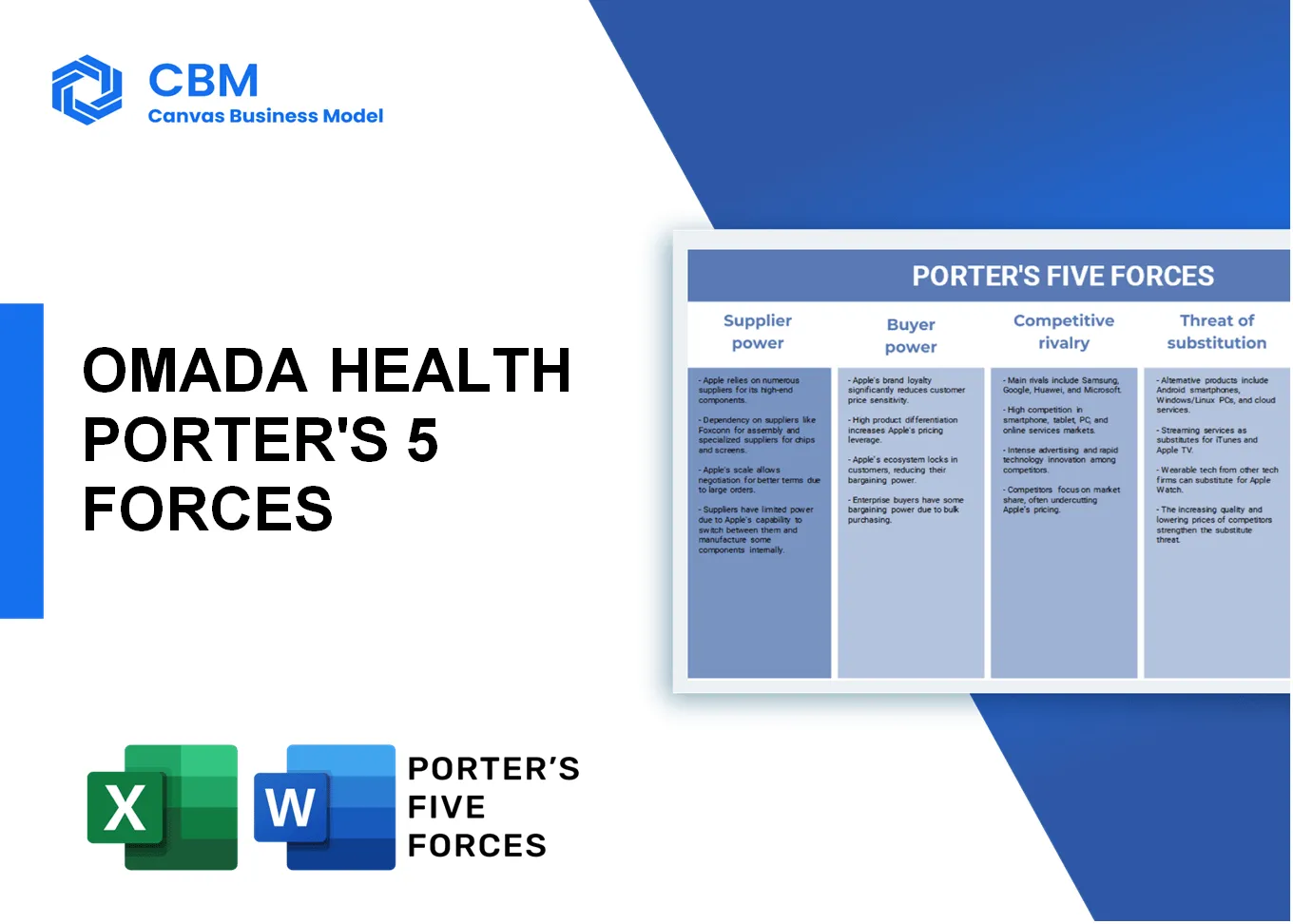In an era where digital transformation is reshaping healthcare, understanding the dynamics of the industry is crucial for companies like Omada Health. By analyzing Michael Porter’s Five Forces, we can uncover the intricate web of influence that suppliers, customers, and competitors weave around this innovative digital behavioral medicine company. From the bargaining power of suppliers to the threat of new entrants, the landscape is ever-evolving and filled with opportunities and challenges. Dive into this essential exploration of market dynamics to grasp what truly drives success in the realm of digital health.
Porter's Five Forces: Bargaining power of suppliers
Limited number of suppliers for specialized technology and tools
The digital health sector relies on a limited number of suppliers for advanced technology platforms and tools. For instance, the market for healthcare software is projected to reach approximately $508.8 billion by 2027, with a compound annual growth rate (CAGR) of 13.3% from 2020 to 2027.
High quality inputs required for effective digital health solutions
To ensure sustainable and effective solutions, Omada Health emphasizes high-quality inputs. The demand for superior quality health data management software led to the average cost per software license for providers being around $5,000 - $20,000 annually, depending on the functionality and user capacity.
Potential partnerships with healthcare providers and organizations
Strategic collaborations can mitigate supplier power. Omada has established partnerships with several large healthcare systems. For example, Omada Health partnered with Blue Cross Blue Shield, which is estimated to cover approximately 106 million members across the U.S., allowing enhanced access to necessary technological resources.
Suppliers may have strong negotiation power in unique offerings
In the specialty market, suppliers who offer unique solutions wield significant negotiation power. Notably, companies providing proprietary data analytics tools, such as IBM Watson Health, can charge premium prices, with contracts averaging around $200 million for large-scale implementations.
Dependence on data analytics and software development expertise
Omada relies heavily on analytics and software expertise. The labor cost for data analytics professionals in the healthcare industry typically reaches approximately $90,000 - $130,000 annually, representing a crucial investment in securing high-level supplier services.
| Supplier Type | Estimated Market Size | Average Cost of Services | Annual Labor Cost for Specialists |
|---|---|---|---|
| Healthcare Software Providers | $508.8 billion by 2027 | $5,000 - $20,000 per license | $90,000 - $130,000 |
| Data Analytics Tools | N/A | Average contracts: $200 million | N/A |
| Healthcare System Partnerships | 106 million members covered | N/A | N/A |
[cbm_5forces_top]
Porter's Five Forces: Bargaining power of customers
Increasing availability of digital health solutions for consumers
The market for digital health solutions is projected to reach $639.4 billion by 2026, growing at a CAGR of 27.7% from 2021. The increase in accessibility of various health platforms is making it easier for consumers to find alternatives to Omada Health's offerings. In 2021 alone, there were approximately 400,000 digital health apps available globally.
High price sensitivity among target demographics
Healthcare consumers exhibit a high level of price sensitivity. Surveys indicate that nearly 67% of consumers consider price as a primary factor in their decision-making process. The average cost of a digital health subscription service ranges from $20 to $200 per month, influencing consumer choices towards more affordable options.
Ability to switch between different health platforms easily
Consumer switching costs for digital health platforms are minimal, with approximately 75% of users expressing that they would easily switch platforms if better value or services were available. The average time taken to transition to a new platform is less than 2 weeks.
Customers' demand for personalized and effective health solutions
Research shows that 86% of consumers are willing to pay more for personalized health solutions, which places pressure on platforms like Omada Health to innovate and tailor their services. A study revealed that 70% of users preferred digital health solutions that adapt to their individual health data and behaviors.
Influence of online reviews and patient testimonies on choice
According to a survey by software advice, 72% of patients use online reviews as their first step in finding a new healthcare provider, emphasizing the need for positive patient experiences. Furthermore, a model indicates that a one-star increase in ratings can lead to an increase in revenue of about 9% in the health service sector.
| Statistic | Value |
|---|---|
| Digital health market size by 2026 | $639.4 billion |
| CAGR (2021-2026) | 27.7% |
| Number of digital health apps available (2021) | 400,000 |
| Percentage of consumers considering price as a primary factor | 67% |
| Average cost of digital health subscription | $20 - $200/month |
| Percentage of users willing to switch platforms | 75% |
| Average transition time to a new platform | Less than 2 weeks |
| Consumers willing to pay more for personalized solutions | 86% |
| Preferred solutions adapting to individual health data | 70% |
| Patients using online reviews to find providers | 72% |
| Revenue increase per one-star rating increase | 9% |
Porter's Five Forces: Competitive rivalry
Numerous players in the digital health and wellness market
The digital health market is projected to reach $508.8 billion by 2027, growing at a CAGR of 28.5% from 2020 to 2027. The number of competitors in this space continues to expand, with over 400 wellness apps available in 2021 alone. Notable competitors include:
- Livongo Health
- Headspace
- Calm
- MyFitnessPal
- Simple Habit
Constant innovation and technological advancements
In 2022, investment in digital health startups reached $29.1 billion, highlighting the rapid innovation occurring in this sector. Companies are leveraging AI and machine learning to enhance user experience and personalize health solutions. For instance, Livongo reported a 62% increase in user engagement through its adaptive learning platform.
Established brands with significant market presence
Established brands such as UnitedHealth Group, which generated $324.2 billion in revenue in 2022, and Aetna, with approximately 39 million members as of 2021, pose significant competitive threats to Omada Health. Moreover, large health systems are increasingly adopting digital solutions, further intensifying competition.
Focus on differentiation through unique offerings and user experience
Omada Health differentiates itself by combining behavioral science with technology to offer personalized health solutions. A survey indicated that 78% of users found Omada’s personalized coaching beneficial compared to 62% for competitors. Furthermore, Omada boasts an impressive Net Promoter Score (NPS) of 62, reflecting high customer satisfaction.
Aggressive marketing strategies to capture market share
Marketing expenditures in the digital health sector are on the rise, with Omada Health reportedly spending around $20 million on marketing in 2021. Competitors like Noom have also utilized extensive advertising, with over $50 million dedicated in the same year. The competitive landscape is characterized by:
| Company | Marketing Budget 2021 (USD) | Market Reach (Millions) | Revenue 2022 (USD) |
|---|---|---|---|
| Omada Health | $20 million | 1.5 | $100 million |
| Noom | $50 million | 5.0 | $400 million |
| Headspace | $30 million | 3.0 | $100 million |
| Livongo Health | $15 million | 2.5 | $300 million |
Porter's Five Forces: Threat of substitutes
Availability of traditional healthcare solutions and methods
The traditional healthcare market is significant, with the global healthcare market expected to reach approximately $11.9 trillion by 2022. Within this framework, patients continue to rely on established medical systems, including clinics and hospitals, which can substitute for digital health interventions.
In 2021, the U.S. healthcare expenditure accounted for about 18% of GDP, indicating robust spending in conventional healthcare.
Growth of DIY health tracking and lifestyle apps
The market for health and fitness apps was valued at $4 billion in 2020 and is projected to reach $10 billion by 2026, with a CAGR of approximately 15.3%. This growth reflects increased consumer interest in self-monitoring and personalized health solutions that can act as substitutes to digital behavioral programs.
In 2021, approximately 80% of smartphone users downloaded a health or fitness app, indicating widespread acceptance of DIY approaches.
Alternatives in fitness and wellness programs (e.g., gyms, personal trainers)
The global fitness industry was valued at around $96.7 billion in 2020 and is projected to reach $130 billion by 2026. This indicates a significant market for fitness alternatives that can serve as substitutes for behavioral medicine interventions.
As of 2022, there are over 40,000 health clubs in the U.S., reflecting the widespread availability of fitness services. In 2021, over 24% of Americans had a gym membership, showcasing a strong potential for alternatives to digital-only solutions.
Over-the-counter health products and services
The global market for over-the-counter (OTC) drugs was valued at approximately $140 billion in 2021 and is expected to grow to $200 billion by 2026. This growth creates a substantial threat of substitution for consumers seeking health improvement options without engaging in personalized digital programs.
In 2020, the U.S. OTC drug market alone accounted for about $40 billion, further emphasizing the scale of alternatives available in the market.
Emerging health technologies with different approaches
The digital health market is expected to reach $509 billion by 2027, indicative of increasing interest in innovative health solutions that can provide substitutes to existing health behaviors.
Telehealth services have seen rapid growth, with a survey indicating that 76% of healthcare providers now offer telehealth options as of 2021, highlighting the emergence of new health technologies that could circumvent the need for app-based interventions.
| Substitute Type | Market Value | Projected Growth (CAGR) | Year of Report |
|---|---|---|---|
| Traditional Healthcare Market | $11.9 trillion | N/A | 2022 |
| Health and Fitness Apps | $4 billion | 15.3% | 2020 |
| Global Fitness Industry | $96.7 billion | N/A | 2020 |
| OTC Drug Market | $140 billion | N/A | 2021 |
| Digital Health Market | $509 billion | N/A | 2027 |
Porter's Five Forces: Threat of new entrants
Low barriers to entry in the digital health industry
The digital health market is characterized by relatively low barriers to entry, primarily due to the minimal initial capital expenditure required to start a digital health service. Reports indicate that the global digital health market was valued at approximately $106 billion in 2021 and is projected to reach around $639 billion by 2026, growing at a CAGR of 39.6%.
New startups emerging with innovative solutions and models
In 2021, over 350 digital health startups received funding, with investments totaling around $14 billion. Notable examples of innovative solutions include:
- Telehealth platforms that facilitated 1 billion virtual visits in 2020 alone.
- AI-driven health management apps that have shown an increase in patient engagement by up to 300%.
- Wearable devices which, according to forecasts, are expected to reach 1.1 billion units shipped globally by 2024.
Potential for increased competition from tech giants entering healthcare
Major technology companies are increasingly entering the digital health arena. As of 2023, companies like Amazon, Google, and Apple have expanded their offerings into health services. For example:
- Amazon acquired One Medical for $3.9 billion in 2022, aiming to integrate healthcare with its existing services.
- Google Health, which has invested over $1.3 billion in health-related projects, poses a notable challenge to existing digital health players.
- Apple has integrated health tracking features across its products, reaching an estimated 100 million users in its health ecosystem by 2023.
Investment interest in digital health attracting new players
Investment in digital health has surged, with venture capital firms investing approximately $29.1 billion in 2021. This interest is evidenced by:
- The record high of digital health funding, which quadrupled from 2019 ($7.4 billion).
- 582 deals were completed in the first half of 2021, indicating a rising trend of new entrants.
Regulatory challenges could deter some new entrants
While the digital health space is inviting, it is not without its challenges. Regulatory compliance can be a significant barrier to some startups. The following figures demonstrate the regulatory landscape:
- In the U.S., obtaining FDA approval for a digital health product can take up to 18 months and costs an average of $1 million.
- Approximately 75% of digital health startups reported regulatory hurdles in 2022.
| Year | Investment in Digital Health (in Billion USD) | Number of Startups | Estimated Users of Health Apps (in Million) |
|---|---|---|---|
| 2019 | 7.4 | 207 | 35 |
| 2020 | 14.7 | 267 | 56 |
| 2021 | 29.1 | 350 | 88 |
| 2022 | 22.1 | 290 | 120 |
| 2023 | 32.4 | 320 | 150 |
In examining the dynamics that shape Omada Health's position within the digital behavioral medicine landscape, it is clear that the interplay of these forces is vital. With the bargaining power of suppliers hinging on specialized resources and partnerships, while customers wield significant influence driven by choices and preferences, the competitive rivalry in this bustling market demands continuous innovation. Moreover, the looming threat of substitutes and the ease with which new entrants can emerge add layers of complexity to the industry. Navigating these challenges effectively is crucial for Omada Health to not only survive but to thrive and foster lasting change in the health journey of its members.
[cbm_5forces_bottom]


![FOX COMP X BOOTS [BLACK] FOX COMP X BOOTS [BLACK]](https://www.flipflopjoy.shop/image/fox-comp-x-boots-black_tuqYUt_300x.webp)









